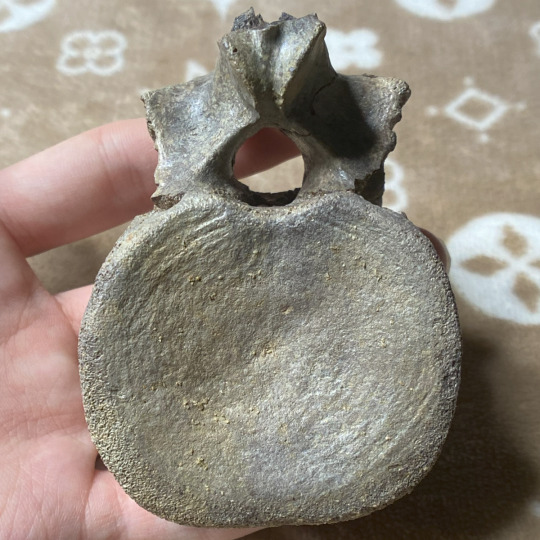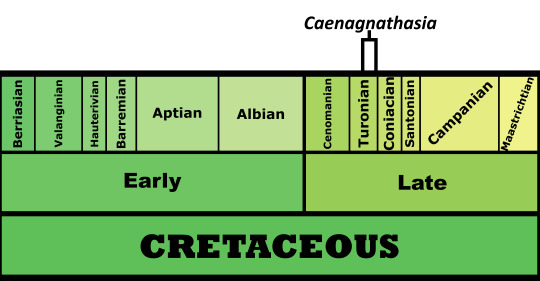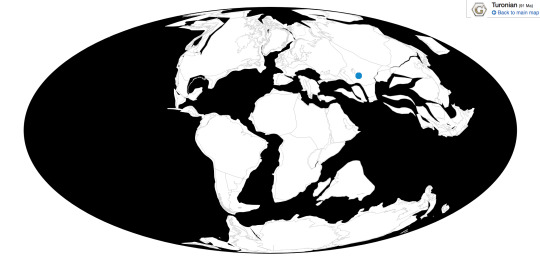#levnesovia
Explore tagged Tumblr posts
Text

A fossilized vertebra of a Levnesovia transoxiana from the Bissekty Formation in Dzharakuduk or Uchkuduk, Kyzylkum Desert, Uzbekistan. This early diverging hadrosauromorph belongs to a group that includes the famous "duck-billed" dinosaurs. This relatively small hadrosaur was likely prey for the basal pantyrannosaur Timurlengia and the large theropod Ulughbegsaurus.
#dinosaur#fossils#paleontology#palaeontology#paleo#palaeo#levnesovia#hadrosaur#ornithopod#ornithischian#cretaceous#mesozoic#prehistoric#science#paleoblr#レヴネソヴィア#ハド��サウルス科#恐竜#化石#古生物学
79 notes
·
View notes
Text
Caenagnathasia martinsoni

By José Carlos Cortés
Etymology: Recent Jaw from Asia
First Described By: Currie et al., 1994
Classification: Dinosauromorpha, Dinosauriformes, Dracohors, Dinosauria, Saurischia, Eusaurischia, Theropoda, Neotheropoda, Averostra, Tetanurae, Orionides, Avetheropoda, Coelurosauria, Tyrannoraptora, Maniraptoromorpha, Maniraptoriformes, Maniraptora, Pennaraptora, Oviraptorosauria, Caenagnathoidea, Caenagnathidae, Elmisaurinae
Status: Extinct
Time and Place: Between 92 and 90 million years ago, in the Turonian of the Late Cretaceous


Caenagnathasia is known from the Bissekty Formation of Uzbekistan

Physical Description: Caenagnathasia was a Chickenparrot, and of the kind with particularly long and shallow jaws, with complex ridges inside. Caenagnathids also were more lightly built than Oviraptorids, with more hollow bones, more slender arms and long, gracile legs. They also weren’t very adapted for running as in other Oviraptorosaurs. Caenagnathasia, however, is not very well known. It’s known from a few jaws from a few individuals, as well as some vertebrae and a femur. We do know that Caenagnathasia is one of the smallest known oviraptorosaurs, and one of the smallest non-avian dinosaurs on the whole. It probably was about 0.61 meters long, and weighed 1.4 kilograms. Other than that, it probably would have resembled other oviraptorosaurs in general - fully feathered and bird like, with extensive wings, a tail fan, a beak, and long legs. It also was probably one of the more basal Caenagnathids.
Diet: Like other Oviraptorosaurs, Caenagnathasia was probably an omnivore.
Behavior: It is likely that Caenagnathasia behaved similarly to other Oviraptorosaurs, though we have no proof either way on that score. It probably would have taken care of its young, creating a large nest with eggs laid around the edge. Caenagnathasia would then sit in the center of the nest and use its wings to keep the eggs warm, like modern birds. These eggs were ovular and elongated, and potentially teal or turquoise in color. Caenagnathasia would have also been an an active, warm-blooded animal, using its wings to communicate with other members of the species and in sexual display. It also would have probably been opportunistic in terms of food eaten, feeding on whatever it could get its wings on.

By Ripley Cook
Ecosystem: The Bissekty Formation was a diverse Middle Cretaceous seashore, filled with brackish swamps and braided rivers along the coast. It probably would have been filled with horsetails, cycads, ferns, and early flowering plants, though no plant fossils are known from the formation. There were a variety of animals in this ecosystem, especially many transitional forms to the iconic dinosaurs of the Late Cretaceous. There was Turanoceratops, a forerunner of Ceratopsids like Triceratops; Levnesovia, an almost-hadrosaurid, as well as other ornithopods Gilmoreosaurus and Cionodon; Bissektipelta, an ankylosaur; Timurlengia, a transitional Tyrannosaurid; Itemirus, one of the earliest known possible Velociraptorines; the troodontids Urbacodon and Euronychodon, and a variety of early birds such as Platanavis, Zhyraornis, and opposite birds like Abavornis, Catenoleimus, Explorornis, Incolornis, Kizylkumavis, Kuszholia, Lenesornis, and Sazavis. There was also a probable Ornithomimosaur that has not yet been named.
Non-dinosaurs were also present, including the huge pterosaur Azhdarcho, many different kinds of fish, some turtles, amphibians, and even sharks that were adapted to the ample brackish water. There were a lot of crocodylomorphs, too, like Zhyrasuchus, Zholsuchus, Kansajsuchus, and an alligatoroid, Tadzhikosuchus. There were also a lot of weird Iguanas, and early mammals as well - herbivorous Zhelestids, burrowing Asiorhyctitherians, insectivorous Zalambdalestids, almost-marsupials, and rodent-like Cimolodonts. This is surely an exciting ecosystem for further research, as it showcases a transition from the Early Cretaceous, to the Late.
Other:
~ By Meig Dickson
Sources under the Cut
Averianov, A.O. 2002. An ankylosaurid (Ornithischia: Ankylosauria) braincase from the Upper Cretaceous Bissekty Formation of Uzbekistan. Bulletin de l'Institute Royal des Sciences Naturelles de Belgique, Sciences de la Terre 72. 97–110. Accessed 2019-03-22.
Currie, P.J.; Russell, D.A. (1988). "Osteology and relationships of Chirostenotes pergracilis (Saurischia, Theropoda) from the Judith River Oldman Formation of Alberta". Canadian Journal of Earth Sciences. 25 (3): 972–986.
Currie, P.J.; Godfrey, S.J.; Nessov, L. (1994). "New caenagnathid (Dinosauria, Theropoda) specimens from the Upper Cretaceous of North America and Asia". Canadian Journal of Earth Sciences. 30 (10–11): 2255–2272.
Kurochkin, 2000. Mesozoic birds of Mongolia and the former USSR. in Benton, Shishkin, Unwin and Kurochkin, eds. The Age of Dinosaurs in Russia and Mongolia. 533-559.
Lamanna, M. C.; Sues, H. D.; Schachner, E. R.; Lyson, T. R. (2014). "A New Large-Bodied Oviraptorosaurian Theropod Dinosaur from the Latest Cretaceous of Western North America". PLoS ONE. 9 (3): e92022.
Paul, G.S., 2010, The Princeton Field Guide to Dinosaurs, Princeton University Press p. 152.
Redman, C.M., and L.R. Leighton. 2009. Multivariate faunal analysis of the Turonian Bissekty Formation: Variation in the degree of marine influence in temporally and spatially averaged fossil assemblages. PALAIOS 24. 18–26. Accessed 2019-03-22.
Sato, T., Y. Cheng, X. Wu, D. K. Zelenitsky, Y. Hsaiao. 2005. A pair of shelled eggs inside a female dinosaur. Science 308 (5720): 375.
Sues, H.-D., and A. Averianov. 2009. Turanoceratops tardabilis—the first ceratopsid dinosaur from Asia. Naturwissenschaften 96. 645–652. Accessed 2019-03-22.
Sues, H.-D.; Averianov, A. 2015. "New material of Caenagnathasia martinsoni (Dinosauria: Theropoda: Oviraptorosauria) from the Bissekty Formation (Upper Cretaceous: Turonian) of Uzbekistan". Cretaceous Research. 54: 50–59.
Sues, H-D., and A. Averianov. 2016. Ornithomimidae (Dinosauria: Theropoda) from the Bissekty Formation (Upper Cretaceous: Turonian) of Uzbekistan. Cretaceous Research 57. 90–110. Accessed 2019-03-22.
Weishampel, David B.; Peter Dodson, and Halszka (eds.) Osmólska. 2004. The Dinosauria, 2nd edition, 1–880. Berkeley: University of California Press. Accessed 2019-02-21.ISBN 0-520-24209-2
Wiemann, J., T.-R. Yang, P. N. Sander, M. Schneider, M. Engeser, S. Kath-Schorr, C. E. Müller, P. M. Sander. 2017. Dinosaur origin of egg color: oviraptors laid blue-green eggs. PeerJ 5: e3706.
#Caenagnathasia martinsoni#Caenagnathasia#Dinosaur#Oviraptorosaur#Chickenparrot#Cretaceous#Omnivore#Eurasia#Theropod Thursday#Bird#Birds#Birblr#Palaeoblr#Factfile#Prehistoric Life#Paleontology#Prehistory#Feathered Dinosaurs
146 notes
·
View notes
Text
Platanavis nana

By Scott Reid
Etymology: Platan Bird
First Described By: Nesov, 1992
Classification: Dinosauromorpha, Dinosauriformes, Dracohors, Dinosauria, Saurischia, Eusaurischia, Theropoda, Neotheropoda, Averostra, Tetanurae, Orionides, Avetheropoda, Coelurosauria, Tyrannoraptora, Maniraptoromorpha, Maniraptoriformes, Maniraptora, Pennaraptora, Paraves, Eumaniraptora, Averaptora, Avialae, Euavialae, Avebrevicauda, Pygostaylia, Ornithothoraces
Status: Extinct
Time and Place: Between 92 and 90 million years ago, in the Turonian age of the Late Cretaceous


Platanavis is known from the Bissekty Formation of Uzbekistan

Physical Description: Platanavis, for better or worse, is only known from a portion of the fused vertebrae above the hip - the synsacrum. As such, we don’t know much about it. We can seem to determine that it was a small proto-bird of some kind, and as such given the time of it being found it was probably not a modern bird (Neornithean). The size was small, and the synsacrum structure indicates that it was probably a short-tailed Avialan - somewhere around the split between Opposite Birds (Enantiornithine) and True Birds (Euornithine). So, what we can glean from that is that Platanavis was small, it was very bird-like, and it probably still had teeth in its mouth. It had a narrow, deep, and not-grooved hip. Beyond that, we cannot be sure.
Diet: Given we know very little of the morphology - especially mouth and teeth shape - of Platanavis, we can’t be sure of its diet; omnivore is probably the most likely thing we can say right now.
Behavior: Well, Platanavis could probably fly in some way, and it probably took care of its young and watched its eggs. Beyond that, we can’t really say much.
Ecosystem: The Bissekty Formation was a very diverse, “middle” Cretaceous seashore ecosystem, filled with brackish swamps and braided rivers along the coast. Unfortunately, the plant life of this environment is not known, but it wouldn’t be surprising if it was filled with horsetails and cycads and ferns, as well as some early flowering plants. It also would have been a very warm environment, being near the equator.

By Ripley Cook
This was an ecosystem filled with a variety of animals that were early versions of the iconic creatures of the Latest Cretaceous, especially in the dinosaurs. There was Turanoceratops, a forerunner of Ceratopsids like Triceratops and Styrcosaurus; Levnesovia, an Ornithopod very close to the soon-to-appear Hadrosaurids; Timurlengia, a transitional Tyrannosaur; Itemirus, one of the earliest known Velociraptorines (possibly, anyway); and Caenagnathasia, one of the earliest “advanced” Chickenparrots. There were loads of proto-birds, too, not just Platanavis - the “True Bird” Zhyraornis, and a gaggle of Opposite Birds including Abavornis, Catenoleimus, Explorornis, Incolornis, Kizylkumavis, Kuszholia, Lenesornis, and Sazavis. Troodontids like Urbacodon and Euronychodon were present, as was some sort of ornithomimosaur. There was also the ankylosaur Bissektipelta, and the ornithopods Gilmoreosaurus and Cionodon.
Non-Dinosaurs in the Bissekty included the huge pterosaur Azhdarcho, a variety of fish, a handful of turtles, some amphibians, and some sharks - many of which were adapted to brackish water that would have been common in the environment. There were also a very diverse selection of crocodylomorphs such as Zhyrasuchus, Zholsuchus, Kansajsuchus, and the earlier alligatoroid Tadzhikosuchus. There were also weird extinct relatives of Iguanas. In addition to all of this, there were a lot of early mammals, weird herbivorous Zhelestids and burrowing Asioryctitherians and insectivorous Zalambdalestids and almost-Marsupials and the rodent-like Cimolodonts. More research on this formation is sure to reveal more fascinating finds!
Other: Platanavis has a similar deep synsacrum to Gobipteryx, and given their similar range and Gobipteryx coming later, perhaps they’re closely related. This would make Platanavis an Enantiornithine, though of course that’s a very preliminary idea.
~ By Meig Dickson
Sources under the Cut
Averianov, A.O. 2002. An ankylosaurid (Ornithischia: Ankylosauria) braincase from the Upper Cretaceous Bissekty Formation of Uzbekistan. Bulletin de l'Institute Royal des Sciences Naturelles de Belgique, Sciences de la Terre 72. 97–110. Accessed 2019-03-22.
Kurochkin, 2000. Mesozoic birds of Mongolia and the former USSR. in Benton, Shishkin, Unwin and Kurochkin, eds. The Age of Dinosaurs in Russia and Mongolia. 533-559.
Mourer-Chauvire, 1989. Society of Avian Paleontology and Evolution Information Newsletter. 3.
Nessov, 1992. Review of localities and remains of Mesozoic and Paleogene birds of the USSR and the description of new findings. Russkii Ornitologicheskii Zhurnal. 1(1), 7-50.
Redman, C.M., and L.R. Leighton. 2009. Multivariate faunal analysis of the Turonian Bissekty Formation: Variation in the degree of marine influence in temporally and spatially averaged fossil assemblages. PALAIOS 24. 18–26. Accessed 2019-03-22.
Sues, H.-D., and A. Averianov. 2009. Turanoceratops tardabilis—the first ceratopsid dinosaur from Asia. Naturwissenschaften 96. 645–652. Accessed 2019-03-22.
Sues, H-D., and A. Averianov. 2016. Ornithomimidae (Dinosauria: Theropoda) from the Bissekty Formation (Upper Cretaceous: Turonian) of Uzbekistan. Cretaceous Research 57. 90–110. Accessed 2019-03-22.
Weishampel, David B.; Peter Dodson, and Halszka (eds.) Osmólska. 2004. The Dinosauria, 2nd edition, 1–880. Berkeley: University of California Press. Accessed 2019-02-21.ISBN 0-520-24209-2
#Platanavis#Platanavis nana#Dinosaur#Bird#Avialan#Birds#Dinosaurs#Birblr#Palaeoblr#Cretaceous#Eurasia#Omnivore#Theropod Thursday#Feathered Dinosaurs#factfile#paleontology#prehistory#prehistoric life#biology#a dinosaur a day#a-dinosaur-a-day#dinosaur of the day#dinosaur-of-the-day#science#nature
90 notes
·
View notes
Text
Sazavis prisca

By Scott Reid on @drawingwithdinosaurs
PLEASE SUPPORT US ON PATREON. EACH and EVERY DONATION helps to keep this blog running! Any amount, even ONE DOLLAR is APPRECIATED! IF YOU ENJOY THIS CONTENT, please CONSIDER DONATING!
Name: Sazavis prisca
Name Meaning: Lute Bird
First Described: 1989
Described By: Nesov vide Nesov & Jarkov
Classification: Dinosauria, Theropoda, Neotheropoda, Averostra, Tetanurae, Orionides, Avetheropoda, Coelurosauria, Tyrannoraptora, Maniraptoriformes, Maniraptora, Pennaraptora, Paraves, Eumaniraptora, Averaptora, Avialae, Euavialae, Avebrevicauda, Pygostylia, Ornithothoraces, Enantiornithes
Sazavis is a poorly known Enantiornithine from the Bissekty Formation of Kyzyl Kum, Uzbekistan. It lived about 92 million years ago, in the Turonian age of the Late Cretaceous. It is known from a single piece of the leg. Though its size is difficult to determine, given the relative lack of material, it probably would have been somewhere near 18.5 centimeters long without the tail. Being an Enantiornithine, it probably would have been a tree-dwelling animal, though that conjecture. It lived alongside other dinosaurs such as Bissektipelta, Cionodon, Gilmoreosaurus, Levnesovia, Turanoceratops, Caenagnathasia, Euronychodon, Itemirus, Kszholia, Timurlengia, Urbacodon, Zhyraornis, Abavornis, Catenoleimus, Explorornis, Incolornis, Kizylkumavis, Kuszholia, Lenesornis, and Zhyraornis.
Shout out goes to @highigor!
Sources:
https://en.wikipedia.org/wiki/Sazavis
https://en.wikipedia.org/wiki/Bissekty_Formation
#sazavis#sazavis prisca#bird#dinosaur#birblr#palaeoblr#highigor#paleontology#prehistory#prehistoric life#dinosaurs#biology#a dinosaur a day#a-dinosaur-a-day#dinosaur of the day#dinosaur-of-the-day#science#nature#factfile#Dìneasar#דינוזאור#डायनासोर#ديناصور#ডাইনোসর#risaeðla#ڈایناسور#deinosor#恐龍#恐龙#динозавр
72 notes
·
View notes
Text
Turanoceratops tardabilis

By Jack Wood on @thewoodparable
PLEASE support us on Patreon! We really do need all of your support to keep this blog running - any amount helps!
Name: Turanoceratops tardabilis
Name Meaning: Turkestan Horned Face
First Described: 1989
Described By: Nesov et al.
Classification: Dinosauria, Ornithischia, Genasauria, Neornithischia, Cerapoda, Marginocephalia, Ceratopsia, Neoceratopsia, Coronosauria, Ceratopsoidea
Our first Ceratopsoid! We’re onto the main - and most famous - group of Ceratopsians, and this is a transitional form between the early Ceratopsians we’ve been looking at, and the later forms. It was originally described off of fragmentary remains, however a more complete skeleton was described in 2009. It had long brow horns like many later Ceratopsids, which wasn’t really seen outside of Ceratopsoidea. It was found in the Bissekty Formation in Uzbekistan, dating back to the Turonian to Coniacian ages of the Late Cretaceous, approximately 90 to 85 million years ago. Don’t let it’s similarity to more derived Ceratopsids fool you - this was a small animal, only about two meters long and less than one meter tall. It lived alongside other dinosaurs such as Levnesovia, Gilmoreosaurus, Cionodon, Bissektipelta, Caenagnathasia, Euronychodon, Itemirus, Kuszholia, Timurlengia, Urbacodon, Zhyraornis, Platannavis, Abavornis, Catenoleimus, Explorornis, Incolornis, Kizylkumavis, Kuszholia, Lenesornis, Sazavis, and Zhyraornis.
Sources:
https://en.wikipedia.org/wiki/Turanoceratops
https://en.wikipedia.org/wiki/Ceratopsia
https://en.wikipedia.org/wiki/Bissekty_Formation
Shout out goes to @tommy-pulled-the-trigger!
#turanoceratops#turanoceratops tardabilis#dinosaur#ceratopsian#palaeoblr#paleontology#prehistory#prehistoric life#dinosaurs#biology#a dinosaur a day#a-dinosaur-a-day#dinosaur of the day#dinosaur-of-the-day#science#nature#factfile#tommy-pulled-the-trigger#Dìneasar#डायनासोर#ديناصور#ডাইনোসর#risaeðla#ڈایناسور#deinosor#恐龍#恐龙#динозавр#dinosaurio#공룡
49 notes
·
View notes
Text
Levnesovia transoxiana

By José Carlos Cortés on @ryuukibart
PLEASE support us on Patreon! We really do need all of your support to keep this blog running - any amount helps!
Name: Levnesovia transoxiana
Name Meaning: Named for Lev Nessov
First Described: 2009
Described By: Sues & Averianov
Classification: Dinosauria, Ornithischia, Genasauria, Neornithischia, Cerapoda, Ornithopoda, Iguanodontia, Dryomorpha, Ankylopollexia, Styracosterna, Hadrosauriformes, Hadrosauroidea
Levnesovia is a Hadrosauroid known from fragments of the skull, found in the Bissekty Formation in Uzbekistan, dating back to the Turonian age of the Late Cretaceous, approximately 90 million years ago. Being one of the older members of the group Hadrosaouroidea, it represents one of its earlier radiations out of East Asia, migrating west to Central Asian locations. It lived alongside other dinosaurs such as Turanoceratops, Gilmoreosaurus, Cionodon, Bissektipelta, Archaeornithomimus, Caenagnathasia, Euronychodon, Itemirus, Kuszholia, Platannavis, Timurlengia, Urbacodon, Zhyraornis, Abavornis, Catenoleimus, Explorornis, Incolornis, Kizylkumavis, Kuszholia, Lenesornis, Nanantius, Sazavis, and Zhyraornis. Given that other large herbivores are known from the formation, it was likely that Levnesovia and others partook in niche partitioning in their ecosystem, with Levnosovia partaking in medium level browsing.
Sources:
https://en.wikipedia.org/wiki/Bissekty_Formation
Sues, H.D., A. Averianov. 2009. A new basal hadrosauroid dinosaur from the Late Cretaceous of Uzbekistan and the early radiation of duck-billed dinosaurs. Proceedings of teh Royal Society B 276: 2549-2555.
Shout out goes to @actone-chasingsuns!
#levnesovia#levnesovia transoxiana#dinosaur#ornithopod#paleontology#prehistory#prehistoric life#dinosaurs#biology#a dinosaur a day#a-dinosaur-a-day#dinosaur of the day#dinosaur-of-the-day#science#nature#factfile#actone-chasingsuns#डायनासोर#ديناصور#ডাইনোসর#risaeðla#dinozor#ڈایناسور#deinosor#khủng long#Dinosaurier#ไดโนเสาร์#恐龍#恐龙#dinosaure
23 notes
·
View notes